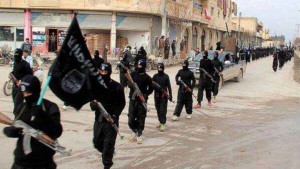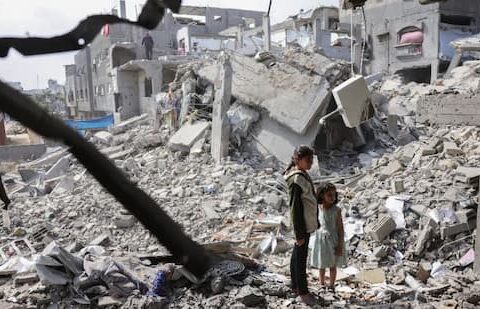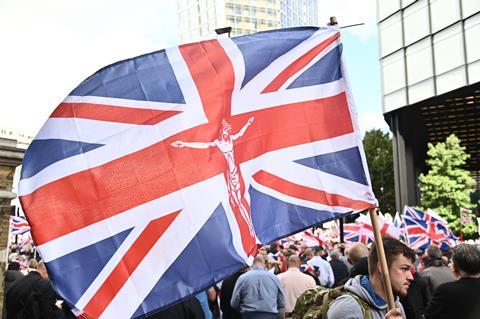Is this really the ‘End of Christianity’ in the Middle East, as many are calling it? If so, why has this happened?
The last remaining Christians in Northern Iraq have been forced into an exodus from their community’s traditional homes; victims of the so-called Islamic State of Iraq and the Levant – or ‘ISIS’, as the the psy-op media prefers to call them.
It is being reported as the biggest mass movement of Christians in the Middle East since the First World War 100 years ago: and, actually, the First World War is very relevant to this subject (we’ll circle back to it).
The Christian communities in Northern Iraq and in the city of Mosul (Biblical ‘Nineveh’, which is apparently the name ISIS prefers to use) have been there for nearly 1,600 years; in fact pre-dating the advent of Islam. Like, of course, many of the Christian communities in the Middle East, they are among the very oldest and very earliest Christian communities in the world.
This exodus follows a medieval style decree/threat by ‘ISIS’ that if the Christian community did not either convert to Islam or pay a special tax for non-believers by 19th July they would be put to death; or to quote specifically, there would be “nothing to give them but the sword”.
The language is extraordinary – it’s like we’ve accidentally gone back in time to the Crusades (or extremists have been watching too much Game of Thrones). For the record, the overly zealous men issuing those decrees mostly aren’t tribal, village-dwelling types like much of the Taliban in Afghanistan – they’re relatively literate, educated people, many of them non-Iraqis and some of them in fact recruits from the UK and other Western countries, even Australia in once instance.

The kinds of situations and the types of language we are seeing and hearing now in the Middle East are increasingly medieval, even Biblical; to the extent that I half expect ISIS’s next “decree” to be the murder of all the first-born children. And I’m not being facetious; it can’t have escaped everyone’s notice that these almost deliberately apocalyptic-styled scenarios and statements are all occurring in the lands historically associated with the Biblical or Abrahamic (as in Judaeo-Christian/Islamic) myths and narratives – Babylon, Syria, Israel, etc – and the lands most associated with the apocalyptic lore of both Christian and Islamic belief systems (Damascus in particular).
It really does, on so many levels, feel like we’re describing events from a darker, less civilised epoch, like something that belongs in history texts and not something that is actually transpiring in the 21st century.
In terms of this sudden turning against Christian minorities, similar treatment and similar ultimatums were inflicted upon ancient Christian communities of Eastern Syria by ISIS’s anti-Assad forerunners during earlier stages of the Syrian Civil War (or Syrian ‘Dirty War’, to be perhaps more accurate).
The Syrian Christian communities are even older than those of Northern Iraq and literally were some of the very oldest Christian sites on the planet, those towns and communities being almost two-thousand years old and from the time of the Gospel era itself.
There are sites in parts of Syria that were visited or occupied by eye-witnesses to the ministry of Jesus and his disciples in their lifetimes, at least according to the tradition.

Some Christians from the town of Maaloula, for example, still speak a form of the otherwise extinct Aramaic, the language of Jesus and his followers.
The tradition has it that Paul of Tarsus established the first organized Christian church at Antioch in ancient Syria; while the head of John the Baptist was believed to be housed in the world-famous Umayyad Mosque (one of the major historic sites that suffered major damage during the fighting). Syria is virtually overflowing with World Heritage Sites, many of which have suffered and will continue to suffer damage due to the ongoing warfare.
Last year, sources inside the Syrian Orthodox Church had reported an “ongoing ethnic cleansing of Christians” being carried out by the Free Syrian Army rebels (a proxy militia backed by the Gulf States, the United States and the West), with claims that over 90% of the Christians of Homs had been expelled by militant Islamist Farouq Brigades going door to door and forcing Christians to flee without their belongings, then confiscating their homes.
These alleged acts were carried out NOT by the so-called ‘ISIS’ terror group, but by the supposedly ‘moderate’ Free Syrian Army championed by Western and international backers.
The Christian population of Homs had dropped from an estimated total of 160,000 before the war to about 1,000. Some have made ominous “Kristallnacht” comparisons to the Nazis seizure of Jewish property; another apt analogy that came to mind for me was the Catholic Church’s medieval persecution and slaughter of several early Christian communities in Europe, particularly the Cathars in France, who wouldn’t subscribe to the dictates of the Holy Roman Church.
The ‘Crisis of Christianity in the Middle East’ is rightly being made much of; but it is worth putting these events in their proper context.
Beginning with correcting the false premise that ‘Islam’ and ‘Christianity’ cannot co-exist or that Islam somehow sees Christianity as an enemy. In reality, the collapse of inter-faith harmony in the Middle East doesn’t have its primary basis in religion, but is part of the broader collapse of the Middle Eastern cultural and socio-political fabric, primarily following the invasion of Iraq and expanded by the covert war on Syria.
In 2003, before the US-led invasion happened, there were an estimated 1.5 million Christians living in Iraq. Today, experts say, there are fewer than 400,000.
The ISIS rampage through Iraq’s Nineveh plains forced an exodus of the Chaldean Christians and other minorities from areas in which they had co-existed for nearly 2,000 years. Attacks targeting Christian communities across the region were substantial, including in Baghdad and Mosul, the persecution of Egyptian Copts in post-Mubbarak Egypt, the occupation of the ancient Christian town of Maaloula by the Western-backed Al-Qaeda affiliate in Syria, and the mass eviction of Christians from their homelands in Nineveh in Iraq.
Propagandists love to spin those events as indicative of some kind of prevalent Islamic attitude towards Christians: this, however, isn’t borne out by history in general, particularly the twentieth century. The No.1 reason for the societal/cultural fragmentation and collapse in the Middle East is the sudden collapse – in just a few years – of the secular, Arab Nationalism that defined states such as Iraq, Syria and Libya prior to war or foreign intervention.
In Iraq, for example, there was never any persecution of Christians under the Ba’athist party – even if there was general oppression of the general population. Indeed Saddam Hussein’s Foreign Minister, Tariq Aziz, was famously Catholic. Aziz, the stories go, used to dismay foreign dignitaries by breaking into ‘Onward Christian Soldiers’ in Aramaic, the language of Jesus.
There has never really been a major sectarian divide between Muslims and Christians in the Middle East beyond the medieval Crusades (which, let’s remember, were started by European Crusaders). While there were doubtless instances of tension or scattered incidents of religious dispute (particularly in countries that have been flooded with low-class ‘madrassas’ or Wahhabi-funded literature, such as in parts of Pakistan), places like Syria were for the longest time fairly well balanced in their rich cultural/religious tapestries.
Writing in the 1920s, for example, British historian Richard Coke wrote the book Baghdad: The City of Peace, recalling “the magnificent scale on which the Christian festivals were celebrated in the churches” and “the many Muslims attending the services, and it was, we are told, a popular custom at holiday times to repair to one of the country monasteries with which the neighborhood abounded, ‘for dancing, drinking and pleasure-making.’”

It is also widely under-appreciated that since around the 19th century, Christian Arabs were playing a central role in defining the secular Arab cultural identity that would later be adopted in Iraq and Syria. Many of the founders of secular Arab nationalism (of the kind that would later be adopted in Syria, Iraq, Egypt, and Gaddafi’s Libya) were men like Michel Aflaq – a Greek Orthodox Christian from Damascus, who is widely regarded as the founder of Ba’athism.
Syria prior to the Civil War was a rich tapestry of diverse ethnic and religious groups, sheltered by Syrian government and society; groups that had all but disappeared elsewhere in the region. As well as the Alawites there were large minorities of Kurds, Armenians, Circassians and Druzes, as well as more arcane groups such as the Yezidi, the Mandeans (a Gnostic sect descended the from followers of John the Baptist) and the Urfalees (Syrian Orthodox refugees from the early Christian centre of Edessa).
All of the sectarian and inter-faith bloodshed that has happened in Syria in recent years has been a sole and direct consequence of the proxy warfare that has unfolded since 2011 – most of which has been orchestrated by foreign powers and entities.
Again, the group that attacked Maloula was the Western/Saudi-backed FSA.
And even the so-called ‘Islamic State group’ itself is certainly tied up in foreign intelligence operations and geo-political agendas. There’s no way this rag-tag group of thugs has accomplished what it has accomplished WITHOUT foreign intelligence involvement and external support: most likely the United States and the UK, the Saudi and Gulf States, Turkey and possibly Israel.
And, at any rate, the sectarian horror story in Iraq is a direct consequence of the illegal US-led invasion of Iraq in 2003 anyway.
This current sectarianism and violence therefore isn’t something that has grown inherently out of Islam or the long history of Muslim/Christian relations – but of collapsed states and widespread disorder due to geopolitical interference.
All of that aside, there is genuine fear now for the future and safety of Christian communities living in the Middle East.
Syria and Iraq are presently the most dire situations, but attacks on traditional Christian communities and interests have been increasing elsewhere in the Middle East for several years now, particularly as a direct result of the collapse of several dictatorships during the so-called ‘Arab Spring’ (a series of initially genuine revolutions by dissatisfied peoples, but which were quickly infiltrated and hijacked by foreign influences and criminal elements).
This breakdown of inter-community relations in these locations has been largely downplayed by the Western media, particularly in the case of Libya in the aftermath of the French-British-American-led military intervention to help Al-Qaeda and foreign militants overthrow Muammar Gaddafi.
In Lebanon, which has seen sectarian violence for decades while remaining the only Arab state with a Christian president, a newly established Sunni group calling itself “the battalion of free Sunnis” has threatened to “cleanse” parts of the country of its Christians.
While the mass expulsion from Mosul has already been called by some journalists the “end of Christianity in Iraq”, there is a broader concern now even among the more temperate schools of political journalism that we are witnessing the broader ‘end of Christianity’ in the Middle East entirely.
Whether this proves to be the case remains to be seen: but if it does follow that trajectory, it will be the result not of supposedly incompatible cultures or religions, but of callous geo-political conspiracies.
The US seemed to be, for example, actively trying to incite sectarian division by removing Saddam Hussein and installing a primarily Shia government in Iraq: a policy that essentially created a sectarian nightmare in the country and contributed to the spread of terrorism in Iraq and the advent of ISIS.

It was a strategy that seemingly made no sense; unless it was designed to lead to this current state of affairs. The Shia militias and death squads committed mass torture, summary executions and generally violent persecution of Sunnis, all of which was triggered and enabled by the US-led regime-change project: a Sunni backlash or retaliation was always inevitable – and what we’re now seeing in the form of the so-called ‘Islamic State’ group is, at least in large part, the form that backlash has taken.
There’s no justification for any of the actions or the brutality of this ISIS terror group: and there’s plenty of evidence to suggest the group is, at least partly, a coordinated psy-op linked to foreign intelligence agencies. But the Sunni backlash caught up in the ISIS nightmare is a direct result of Shia persecution and massacres of Sunni communities – all of which was enabled and even encouraged by US occupation forces.
The Christian communities now are getting caught up in some of the fall-out from all of that: from the illegal invasion, from the Dirty Wars and proxy militias and regime-change projects of the passed several years.
It is unlikely that the controlling powers and interests behind these wars and regime-change projects have any real care for the Middle East’s Christian communities, any more than they care about the Sunnis in Iraq, the women of Libya, or about the region’s Kurdish minorities.
A necessary question emerges, at any rate: has this whole nightmare – including the threat to old Christianity in the Middle East – been sought and orchestrated by outside agencies?
Let’s put this current horror story in the Middle East into its proper, fuller context first.
It was the British and French Imperial powers that created the Middle East as it looks today. They did so a century ago, after World War I, when the Sykes-Picot agreement carved up the region according to British and French commercial and colonial interests. Syria, Egypt, Iraq, Saudi Arabia, Israel, etc, as we know them today, were all created as nations during this period and in this context: along with all of the sectarian problems that the Sykes-Picot carve-up created.
This same period – and same series of geo-political games – created the Saudi Royal Family and its hugely influential state, as well as the State of Israel under the British-linked Zionist project.

All of this was done not to serve Middle-Eastern interests or Arab interests, Muslim interests or Christian interests or Jewish interests: but the commercial and colonial interests of the British and French empires of the time (and of the subsequent controlling interests in decades of geo-politics).
Every crisis – sectarian, religious or purely political – since then appears to be a consequence of those decisions.
This would include the plight of Palestinians (Muslim, Christian and atheist alike), the spiralling of Anti-Semitism or anti-Jewish feeling, the Sunni/Shia sectarian problems (ruthlessly exacerbated by the illegal invasion of Iraq and subsequent Dirty War in Syria), and even the persecution of the Kurds in various locations.
Is the current plight of the Christian minorities in that part of the world part of that equation, even a century later?
Or is it merely an unplanned consequence? Are the region’s Christians simply regarded as collateral damage?
The more one understands or examines history – which is what most scholars and experts do, as opposed to relying purely on current affairs and contemporary biases – the more it is evident that Muslims and Christians have largely lived in peace with each other, including Christians living within Islamic societies. If anything else was the case, then the Christian holy sites in Jerusalem simply would not have remained Christian for all these centuries.
Nor would Christian communities and sites in Syria and Iraq have remained unscathed for centuries prior to the current conflict(s). It is famously known, for example, that one of the holiest sites in Christianity, the Church of the Holy Sepulchre in Jerusalem – held by Christians to be where Jesus was buried and rose from the dead – has been under the continual custodianship of Muslim families since at least the 12th century to this day and preserved an an entirely Christian site, in part because differing Christian denominations have rival claims to the site.
Again, if the headlines prove to be correct and this is the ‘End of Christianity in the Middle East’, it will be the result not of supposedly incompatible cultures or religions, but of callous geo-political conspiracies – both a century ago and in the present day.





You completed some nice points there. I did a search on the theme and found most persons will have the same opinion with your blog.